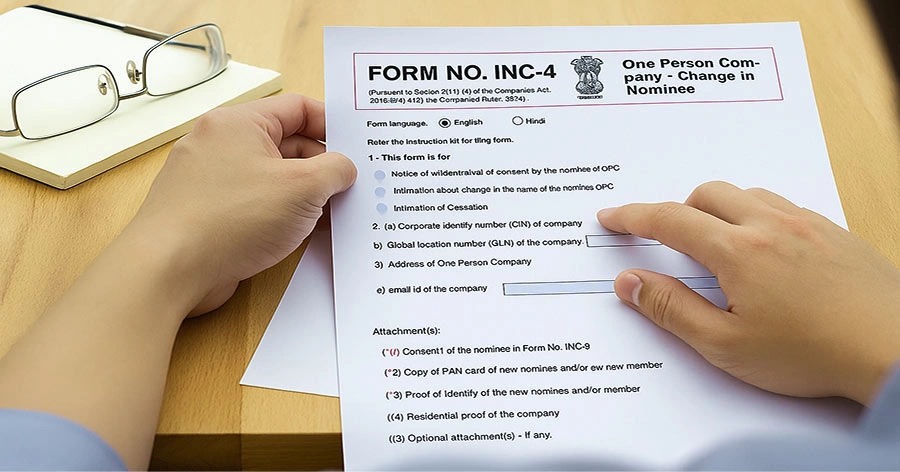
For small business owners in India, compliance, and growth within the framework of government regulations are key to success. If you are the owner of an OPC company or are considering registering as one, you must understand the OPC turnover limit and how it impacts your business. The OPC turnover limit is a crucial parameter that determines whether your business continues to operate as a One Person Company (OPC) or transitions into a broader business structure.
This blog will not only clarify financial limits for OPC companies but also explain strategic ways to manage growth efficiently while complying with legal norms. We’ll discuss what is One Person Company, why the turnover limit matters, and offer actionable tips for handling it effectively. Let’s begin!
Also Read: What Are the Types of OPC?
What is an OPC?
To truly understand the OPC turnover limit, it’s essential to first grasp the basic structure of an OPC business.
What is One Person Company?
An OPC, or One Person Company, is a corporate structure limited to a single owner, as defined under the Companies Act, 2013. This model was introduced by the Indian government to encourage micro and small entrepreneurs to incorporate their businesses without needing multiple partners.
Key Features of an OPC:
- Operated by a single individual.
- Limited liability for the owner to protect personal assets.
- Simplified tax compliance compared to larger firms.
- Suitable for startups, sole proprietors, and freelancers aiming for scalability.
This structure bridges the gap between sole proprietorships and private limited companies, offering both flexibility and legal recognition. However, the growth potential of an OPC is constrained by the OPC turnover limit.
The Concept of OPC Turnover Limit
The OPC turnover limit refers to the total annual revenue threshold that an OPC can generate before it is no longer eligible to operate as a One Person Company.
Current OPC Turnover Limit as of 2025:
According to the Companies Act, 2013, the limit for an OPC is:
- ₹2 crores paid-up share capital, OR
- ₹20 crores annual turnover.
If your OPC company crosses either threshold in any financial year, you’ll be required to convert it into a private limited company or another appropriate structure.
This rule ensures that OPCs focus on small entrepreneurs while encouraging larger entities to migrate toward scalable, multi-partner models.
Why is the OPC Turnover Limit Important?
The OPC turnover limit serves several critical purposes in the corporate ecosystem. Let’s take a closer look at its importance:
1. Promotes Scalability:
The limit facilitates the smooth transition of small businesses into larger corporate structures when they outgrow the confines of being an OPC.
2. Streamlines Legal Compliance:
Small-scale entrepreneurs benefit from reduced compliance requirements as OPC structures simplify filing and reporting compared to other company forms.
3. Protects Market Dynamics:
By limiting turnover, the government ensures that the OPC framework is exclusively for small businesses and does not distort competition among larger corporate bodies.
Understanding these factors helps entrepreneurs better align their growth goals with regulatory restrictions.
How Does the OPC Turnover Limit Impact Small Businesses?
The OPC turnover limit can significantly influence the decisions and operations of small businesses. Here’s how:
1. Strategic Financial Planning
Businesses must keep close track of their earnings and plan for long-term scalability. If approaching the turnover threshold, an OPC company must prepare for restructuring its business model.
2. Decision-Making on Expansion
For small businesses experiencing rapid growth, the need to transition beyond the OPC company framework directly shapes how they approach expansion. Larger fundraising efforts, partnerships, or investments may require switching to a private limited company.
3. Tax and Compliance Implications
Exceeding the turnover limit introduces increased compliance requirements, such as tax audits, additional filings, and adherence to new legal obligations.
Steps to Handle the Turnover Limit Transition
Crossing the OPC turnover limit doesn’t need to hinder your business operations. Here are strategic steps to ensure a smooth transition:
1. Monitor Turnover Closely:
Use accounting tools or hire a professional to ensure that your financial reports are accurate. Keep an eye on whether you’re nearing ₹20 crores in revenue.
2. Consult Experts for Restructuring:
Reach out to business consultants, to guide you through restructuring into a private limited company or LLP. This minimizes compliance risks and operational disruptions.
3. Notify MCA:
If your turnover crosses the prescribed limit, you are required to notify the Ministry of Corporate Affairs (MCA) and seek approval for the change in your company structure.
Advantages of Exceeding the Turnover Limit
Although exceeding the OPC turnover limit implies transitioning the company structure, it also presents growth opportunities:
- Access to Funding: Transitioning to a private limited or LLP format may attract more investors and business loans.
- Higher Credibility: Large businesses gain greater credibility in terms of marketability and client trust.
- Opportunity for Partnerships: A revised structure allows multiple shareholders, partnerships, and team expansions.
While the additional compliance requirements may seem daunting initially, the long-term benefits of scaling outweigh the challenges.
Challenges Associated with the Turnover Limit
Understanding what is one person company and its regulations also means recognizing the challenges when crossing the turnover threshold:
- Documentation: Preparing and filing all restructuring documents requires time and expertise.
- Increased Regulatory Burden: Transition means adhering to more compliance standards, such as board meetings, financial statements, and statutory audits.
- Cost Implications: From legal fees to higher operational costs, restructuring requires financial planning.
With the right strategic approach, these challenges can be mitigated by consulting professional services like RegisterKaro.
Conclusion
The OPC turnover limit plays an essential role in regulating the growth and compliance of small businesses in India. While it encourages entrepreneurs to scale their operations responsibly, it also ensures smoother transitions into larger organizational models when required.
By understanding what is one person company, complying with turnover limits, and knowing when and how to restructure your business, you can unlock long-term growth opportunities while remaining compliant with government regulations.
Planning to set up a One Person Company or need guidance for a turnover threshold transition? Reach out to RegisterKaro today for tailor-made solutions designed for growing businesses like yours.
FAQs
1. What is the turnover limit for an OPC?
The turnover limit for an OPC is ₹20 crores annually, or ₹2 crores in paid-up share capital.
2. Can an OPC have more than one director?
Yes, an OPC can have more than one director, but only one shareholder is allowed.
3. What happens if my OPC exceeds the turnover limit?
Exceeding the OPC turnover limit will require converting your OPC into another business entity, such as a private limited or LLP.
For more details, visit the Ministry of Corporate Affairs official website.




